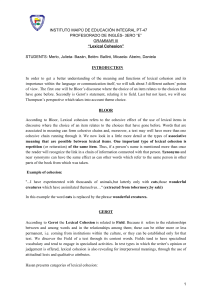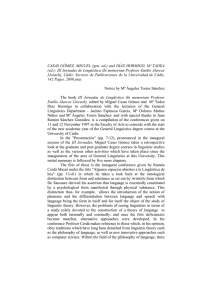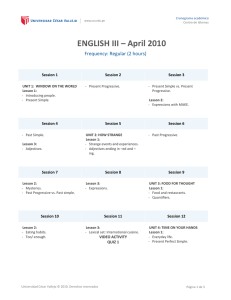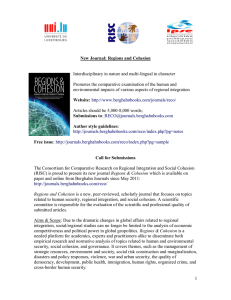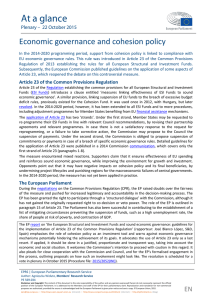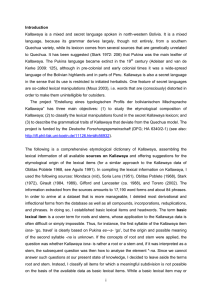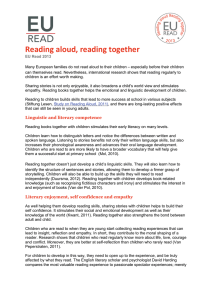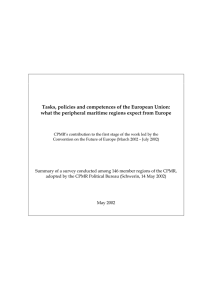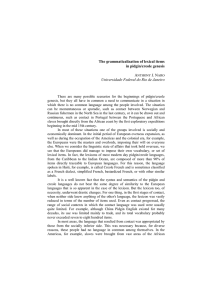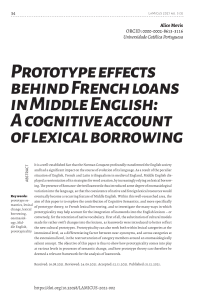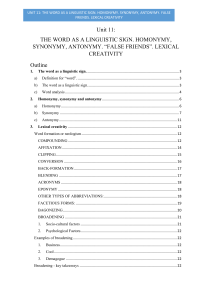05. Linguistic analysis of impairment data. 05.03. Textual - OCW-UV
Anuncio
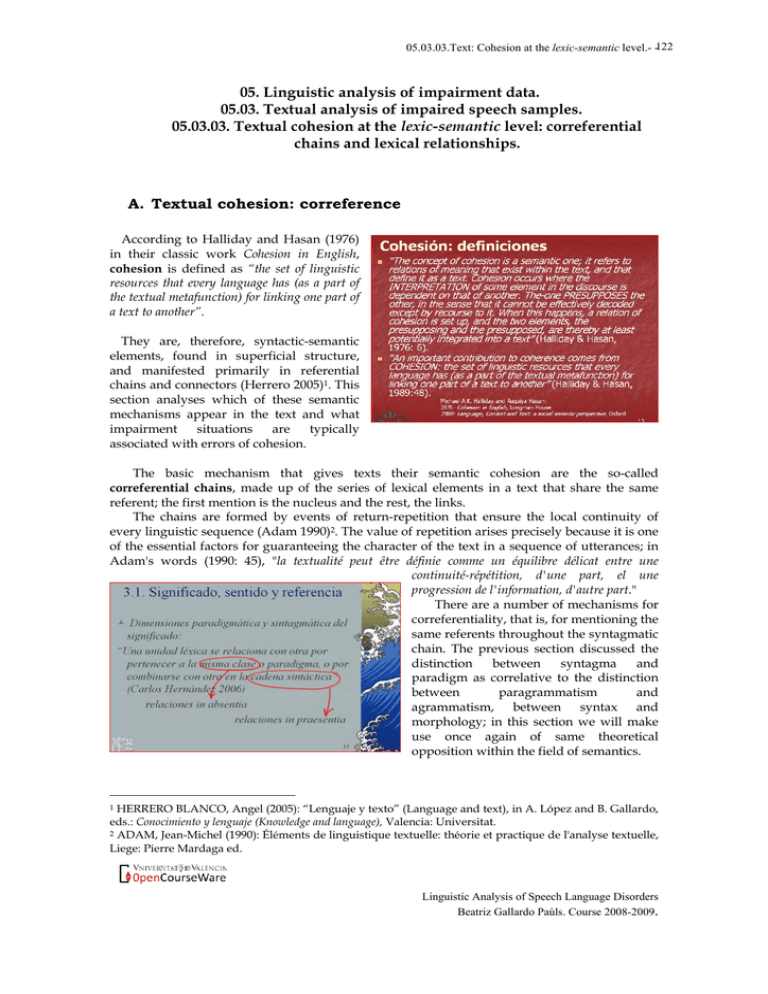
05.03.03.Text: Cohesion at the lexic-semantic level.- -122
05. Linguistic analysis of impairment data.
05.03. Textual analysis of impaired speech samples.
05.03.03. Textual cohesion at the lexic-semantic level: correferential
chains and lexical relationships.
A. Textual cohesion: correference
According to Halliday and Hasan (1976)
in their classic work Cohesion in English,
cohesion is defined as “the set of linguistic
resources that every language has (as a part of
the textual metafunction) for linking one part of
a text to another”.
They are, therefore, syntactic-semantic
elements, found in superficial structure,
and manifested primarily in referential
chains and connectors (Herrero 2005)1. This
section analyses which of these semantic
mechanisms appear in the text and what
impairment
situations
are
typically
associated with errors of cohesion.
The basic mechanism that gives texts their semantic cohesion are the so-called
correferential chains, made up of the series of lexical elements in a text that share the same
referent; the first mention is the nucleus and the rest, the links.
The chains are formed by events of return-repetition that ensure the local continuity of
every linguistic sequence (Adam 1990)2. The value of repetition arises precisely because it is one
of the essential factors for guaranteeing the character of the text in a sequence of utterances; in
Adam's words (1990: 45), "la textualité peut être définie comme un équilibre délicat entre une
continuité-répétition, d'une part, el une
progression de l'information, d'autre part."
There are a number of mechanisms for
correferentiality, that is, for mentioning the
same referents throughout the syntagmatic
chain. The previous section discussed the
distinction
between
syntagma
and
paradigm as correlative to the distinction
between
paragrammatism
and
agrammatism, between syntax and
morphology; in this section we will make
use once again of same theoretical
opposition within the field of semantics.
HERRERO BLANCO, Angel (2005): “Lenguaje y texto” (Language and text), in A. López and B. Gallardo,
eds.: Conocimiento y lenguaje (Knowledge and language), Valencia: Universitat.
2 ADAM, Jean-Michel (1990): Éléments de linguistique textuelle: théorie et practique de l'analyse textuelle,
Liege: Pierre Mardaga ed.
1
Linguistic Analysis of Speech Language Disorders
Beatriz Gallardo Paúls. Course 2008-2009.
05.03.03.Text: Cohesion at the lexic-semantic level.- -123
When studying the possible semantic errors made by a speaker with impairment, we
should ask ourselves if these errors refer to the lexical class (paradigm) or of they affect the
sentence chain (syntagma).
To carry out this analysis we must be aware that there are two basic types of correferential
mechanisms: those that use alternative lexical designations for the same reality (lexical
correference) or those based on grammatical techniques, such as phoric deixis, determination or
basic alternants.
1.
Lexical correference
This mechanism consists in using alternative lexical units for the same reality; it maintains a
homogeneous continuum of meaning (minimum isotopy3) and at the same time ensures a
certain progression with new specifications, updating within the discourse the virtual
references of the lexemes mentioned. It is based on lexical relations:
Synonymia: repeats a certain lexical element with a different lexical element that
maintains a relation of "identity" with the first; can occur at a strictly lexical level
(word 1 = word 2)4 or at the syntagmatic level (including appositions). For example,
Down's Syndrome (and other impairments) is typically associated with lexical
poverty that makes using synonymia difficult.
Hyponymy and Hyperonymy: relations of lexical inclusion; hyperonomy is the term
used to designate the general class (‘mueble’ - furniture) and hyponymy is used for a
member of that class ('silla' - chair).
[Suggested additional reading: “Caso de demencia
semántica”(A case of semantic dementia), Marisol Reyes
Nava 2006]
Strictly speaking, lexical impairment is
anonymy, or difficulty in accessing words; its
minimal manifestation, which is not necessarily
pathological, is the well-known phenomenon of
"on the tip of the tongue". There are other
symptoms of lexical and semantic impairment,
such as perserverances, stereotypes, echolalia,
and glossomanias or preferred topics.
Textual isotopy: a concept formulated by Greimas to address intra-textual coherence of discourse (1976:
20) "the recurring appearance throughout a discourse of a bundle of categories justifying paradigmatic
organisation". / "isotopy is a semantic property of the text that enables the homogeneous levels of meaning
to be highlighted and is based on the redundancy and reiteration in several textual segments of some
identical semantic elements; the latter constitute a base onto which the particular meanings of each text
segment are inserted, but their specificity does not entail either the dispersion or the irreconcilability of the
various meanings". (Lozano et al. 1986: 31) LOZANO, Jorge, PEÑA-MARIN, Cristina and ABRIL, Gonzalo
(1986): Análisis del Discurso (Discourse analysis), Madrid: Cátedra.
4 For example, Bernárdez includes here only the cases of a sole lexeme: estatua for escultura, automóvil for
coche, caminar for andar, etc.
3
Linguistic Analysis of Speech Language Disorders
Beatriz Gallardo Paúls. Course 2008-2009.
05.03.03.Text: Cohesion at the lexic-semantic level.- -124
2.
Grammatical correference
In grammatical, non-lexical correference, the links in the referential chain refer basically to
alternants, that is, the elements in the linguistic code that allude to previous referents by
means of linguistic forms which, despite being explicit, do not transmit their own
propositional meanings.
Deixis: deictic elements are those that place the spatial and temporal text referents
(demonstrative deixis) or by reference to other elements in the same text (phoric
deixis). According to Bühler's classic distinction, there can be three types of deictic
use:
o
1) ad oculos (exophoric) deixis: a pragmatic category that occurs in the
enunciative and textual field, and that serves to place the referents in the
statement by reference to those in the content of the utterance, at spatial,
personal and temporal levels. In any message there is a series of elements
whose referential meaning depends on the communicative situation, of the
HERE and NOW of the utterance; it is therefore an exophoric reference.
Being native speakers of Spanish does not give us sufficient ability to
correctly interpret message of the type Te espero mañana donde siempre (I'll
wait for you tomorrow in the usual place). Deictics serve to encode different
types of elements that depend on the enunciative situation.
o
2) phoric deixis (anaphoric and cataphoric): “Parmi les phénomènes
d’enchaînement transphrastique assurant l’isotopie textuelle, conformément à la
règle de récurrence dégagée par les grammairiens du texte, l’anaphore et la
cataphore jouent un rôle prépondérant, en même temps qu’elles requièrent de la part
des sujets qui les utilisent une compétence spécifique” (Reichler-Béguelin,
1988:15).
o
3) deixis am phantasma or of imagination: refers to elements not present in
the discourse, that is, based on memory or imagination: cuando llegues a
Correos giras a la derecha y a partir de ahí, la segunda bocacalle (when you get to
the Post Office you turn right and from there it's the second turning).
[Suggested additional reading:
“La cohesión y la coherencia en la conversación del paciente con
demencia: Un estudio discursivo” (Cohesion and coherence
in the conversation of the dementia patient: a discursive
study), Beatriz Valles González
“El efecto de la distancia en la comprensión escrita de los
demostrativos con valor anafórico” (The effect of distance on
the written comprehension of demonstratives with
anaphoric value), Julio González, Tersa Cervera and José
Luis Miralles, 1999
“Análisis de frecuencias de construcciones anafóricas en
narraciones infantiles” (Analysis of the frequency of anaphoric
constructions in children's stories), César Aguilar 2003]
Determination: the use of indefinite or definite articles gives different results. As
H. Weinreich (1976: 169) argues that "For the listener, the indefinite article has the signic
value of attracting their attention to forthcoming information. On the contrary, the definite
Linguistic Analysis of Speech Language Disorders
Beatriz Gallardo Paúls. Course 2008-2009.
05.03.03.Text: Cohesion at the lexic-semantic level.- -125
article signals that here, previous information is of interest". (trans. in Bernárdez, 1982:
136). For Halliday and Hasan (1976: 136), the definite article "indicates that the element
in question is specific and identifiable; that the information required for identification can be
recovered from somewhere. Where should this information be searched for? ... either in the
situation or in the text. The reference is exophoric or endophoric". (trans. in Bernárdez,
1982: 136). Another common opposition distinguishes between the presenting
determinators (un, uno, una, unos, unas) and the recognising determinators (el, la, los,
las).
Pronominalisation: pronominal substitution uses specialised elements as
substitutes, instead of autosemantic elements. Basic alternants (Bloomfield's concept)
are defined as "linguistic elements whose function is to serve as a substitute for a lexical
element in the same text". (Bernárdez, 1982: 105)5.
They include lexical basic alternants (pro-verbs, pronouns: hacer, cosa, hecho,
persona), pronouns and pro-adverbs (entonces, así). For personal pronouns, only those
in third person can really be regarded as basic alternants, that is, textual substitutes of
elements that have already appeared in the text or that will appear later (according to
their anaphoric or cataphoric use). Basic alternants are frequently found in speakers
with anonymy, as lexical access impairment is compensated by the over-exploitation
of these empty categories.
1st and 2nd person pronouns are used with an exophoric or contextual function,
that is, linked to the enunciative situation; endophoric use is only possible in the 3rd
person. Other pronouns with a substitutive textual function are (Bernárdez, 1982:110)
reciprocal, reflexive, relative, indefinite, possessive and demonstrative. In summary,
Bernárdez argues that "all basic alternants set up a full reference identity, although they
limit their value to indicating that what we find at a point in the text should be identified
exactly with something that has previously appeared in the same text, or that we can identify
extra-textually from our 'knowledge of the world' or of the context". (1982:116).
[Suggested additional reading: “Coherencia y cohesión en el
discurso afásico” (Coherence and cohesion in aphasic
discourse), Lourdes de Pietrosemoli,1996 ]
B. Textual cohesion: connectors
Together with correferential chains, there is a second cohesion mechanism that, for
its importance, is sometimes dealt with separately: this is connectivity, defined as:
the dimension of cohesion that deals with chaining utterances and/or sentences
inside a text.
A cohesion mechanism that is set up between two (and sometimes more)
constituents of a sentence (INTRA-SENTENCE connection of compound sentences) or
between two elements in the text (EXTRA-SENTENCE or TEXTUAL) and a connector,
which displays the syntactic, semantic or pragmatic relation between these elements
(Cuenca 2006: 13-14).
BERNÁRDEZ, Enrique (1982): Introducción a la Lingüística del Texto (Introduction to text linguistics), Madrid:
Espasa-Calpe.
5
Linguistic Analysis of Speech Language Disorders
Beatriz Gallardo Paúls. Course 2008-2009.
05.03.03.Text: Cohesion at the lexic-semantic level.- -126
The analysis of stories written by children with ADHD provides a framework for studying
connection in the area of pathologies. This impairment is manifest in the composition of
incomplete narrative events, or in the use of connectors to incorrectly link some categories of
the narration. We can see this in the
following text by ITS, aged 11, with
Combined type ADHD: The big desert island
"Once a soldier received a call and he
told a policeman, but he lied to him. It was a
treasure, but the policeman was cleverer and he
followed him to the desert island that he was
going. The soldier got off the launch but the
launch disappeared, and the policeman's [launch]
when the policeman got off. On the island the
soldier was walking and found a magic letter. He
read and it said: in this letter you can get
everything you want.
"-Then I'll conquer the world and be the
strongest. Then he and the policeman fought".
Linguistic Analysis of Speech Language Disorders
Beatriz Gallardo Paúls. Course 2008-2009.
05.03.03.Text: Cohesion at the lexic-semantic level.- -127
(cf. Relevant chapter in Pragmática para logopedas - pragmatics for speech therapists).
Linguistic Analysis of Speech Language Disorders
Beatriz Gallardo Paúls. Course 2008-2009.
